Written by John Edward BetancourtAs the con craze continues to overtake nerds and geeks alike in our proud state of Colorado, the city of Colorado Springs is quickly becoming a beacon for the constant expansion of new conventions and events to celebrate the things we love. Over the past few years, we've seen one new con after another put down roots south of Denver, and one of them has certainly caught our eye this year...Colorado Cosmic Con.
Now in its second year, this convention is quickly establishing itself as one of the premier events in the state, bringing together a collection of fun guests and events to keep all of us entertained, and since they're looking to build upon their solid success from year one, Colorado Cosmic Con has already added some awesome guests to their lineup for 2016. This year, you'll able to meet Erin Cahill, Alison MacInnis and Yoshi Sudarso from Power Rangers, and they even managed to book the legendary Sgt. Slaughter of WWE fame. In addition to those guests, you'll also be able to check out plenty of vendors and artists, including the legendary Frazetta Girls and one of our good friends, Mister Robert Elrod. But in addition to meeting all these guests, a con wouldn't be a con without plenty of activities planned and CCC is no exception to that rule. You'll also be able to see 'Baby' from Supernatural and come Saturday night, you can hit the dance floor and shake the night away at the Saturday dance and enjoy a little Karaoke that evening as well. Either way, this is just the beginning for what Colorado Cosmic Con has planned for us, since they're currently working on putting together so much more before the con kicks off this October 22nd & 23rd, which means it would be wise to keep an eye on their Facebook page and website (it is under construction at the moment, but that's always a good sign that new things are on the way), and the reason we here at Nerds That Geek are talking about it so early...is because CCC is currently offering one hot deal on their VIP tickets...for a limited time. That's right, if you want early access to the con by thirty minutes, and priority seating to any panel and the Cosplay Contest, swing by their ticketing site and pickup your VIP pass for only $25. But act quickly, we can't stress enough that this is a limited time offer, so snag your tickets today, and keep checking back with us and CCC's social media feeds for more news about this convention and any new guest announcements, and we will see all of you at the DoubleTree Hotel in Colorado Springs for Colorado Cosmic Con 2 this fall!
0 Comments
Denver Comic Con 2016 Panel Spotlight: "Sound Design and Scoring in J.J. Abrams’ 'Star Trek' Films"7/20/2016 Written by Tim Girard Sound Design and Scoring in J.J. Abrams’ 'Star Trek' Films Saturday, June 18, 2016 1:30pm-2:20pm Cali Thrailkill, Mary Odbert, Sebastian DeTemple Before beginning the presentation, Cali Thrailkill and Mary Odbert, who both studied music and film, explained the difference between diegetic and non-diegetic sound. Diegetic sound is any sound that takes place in the world of the narrative. They are sounds “whose source is visible on the screen or whose source is implied to be present by the action of the film: voices of characters, sounds made by objects in the story, music represented as coming from instruments in the story space” (FilmSound.org). The sounds can be on or off screen, but if it is something that the characters could hear, then it is diegetic. A non-diegetic sound is any “sound whose source is neither visible on the screen nor has been implied to be present in the action: narrator’s commentary, sound effects which are added for the dramatic effect, mood music”. Some sounds may function as both simultaneously, or morph from one to the other. The great example they gave of this is when a young James T. Kirk steals a car (in the film it seems as though it's his stepfather's car, but according to Imdb, and the novelization, it is his father's car and his stepfather is going to sell it while his mother is off-planet) and turns on the media player. It is clear that the song playing ('Sabotage' by the Beastie Boys) is heard by Kirk, so it is a diegetic sound. As the scene continues, the song continues to be heard by the audience at the same level, even when the car is far off in the distance (and falls off the cliff). This shows that is has crossed over into being a non-diegetic sound. Another big talking point was that many of the sounds (or variations) from the original series and films were used in the reboot. Most importantly was the "sonar ping" sound that so characteristic that most of you probably just heard it in your heads. This sound and other distinct sounds let the viewers know that we are on the bridge of the Enterprise. They also pointed out that almost no scoring is used while they are on the bridge. This use of diegetic sound design could possibly be a way of subtly immersing the viewer in the environment, without "telling them what they should be feeling," which is sometimes the role of the score. There were also alarm noises on the Kelvin which obviously indicated to both the characters and the viewers that there was an emergency. This same alarm sound was used when Vulcan was about to be destroyed. This is a diegetic sound to the characters, but also a non-diegetic signal to the audience saying, "you know what happens when you hear this sound." Nero's Romulan "bad guy" ship, the Narada doesn't have the same type of ambient sounds as the Enterprise. Since it is a mining ship, there are mostly "industrial sounds" and any "beeps" are reactive (only when you push a button). In Star Trek Into Darkness, on Admiral Marcus' ship the Vengeance the sonar ping is lower and slower. On a diegetic level, this could be explained by the fact that it is a much bigger ship than the Enterprise, and bigger things are usually lower in pitch and slower. This is yet another sound that also has a non-diegetic role, and that is as a red flag to the viewer that something is not quite as it seems with this ship and its captain. In many cases, a sound designer has to ask his/herself what is more important for each scene: the practical reality or setting the mood. Fortunately, most of the sounds used in Star Trek serve both purposes. On the opposite end of the spectrum is the discussion about silence. The director of any film that takes place in space has to make the decision between realism and entertainment: silent space or the sounds of weapons, explosions, sound effects, and music. Luckily, Star Trek gives us the "ear candy" that we want during all of the action scenes, because, as the presenters put it, “If you are going to see a science fiction movie, there have to be 'pew pews’.” This isn't to say that there are never moments of silent space, but when it is used, it is very intentional and also serves a dual purpose as both diegetic and non-diegetic "sound." These instances (only four, according to the presenters) are when characters are exposed in space, and the silence is used to highlight the isolation, fear, and tension from the point of view of the character. Imagine a scene where there are the sounds of intense action/battle music, alarms going off, weapons being fired, crew members shouting and screaming, and explosions tearing a ship apart... then imagine the impact of all of that cutting out and being left with only silence as a crew member flies out of a newly made hole, to die alone, floating in the vastness of space. In addition to sound design, Thrailkill and Odbert also discussed Michael Giacchino's scores for J.J. Abrams' Star Trek films. The main purpose of the score is for emotional signaling: to tell the audience what they should be feeling during a scene. The main theme, which was referred to as the "Courage Theme," has a heroic, triumphant quality with a sense of adventure. It gives the broad open feeling of the positive exciting aspects of floating in space, as opposed to the terrifying use of silence to represent dying in space. One of the early significant uses of this theme (after the opening title) is the first time we see the U.S.S. Enterprise. It is also used for moments of triumph. Another significant moment is at the end when they eject the warp core and detonate it so the explosion pushes them out of reach of the black hole that they are being sucked into. If sound effects were used for the sound of the explosion, then that moment would probably have been the climax of the scene. Instead, the explosion is silent (silent space), which creates tension; followed by sound effects from the ship (diegetic sound), which build intensity; and then the climax is when the Courage Theme (non-diegetic sound) is heard as the Enterprise breaks free of the explosion. Probably one of the most poignant uses of the Courage Theme is in Into Darkness after Kirk fixes the warp core and is talking to Spock as he is dying. It is a somber treatment for a delicate solo piano, accompanied by strings. The strings take over when Spock tells him that he is feeling and has the realization of how important their friendship is, and the climax of this interlude is when their hands "touch" through the glass. There is an echo of the Courage Theme on piano for Kirk's final moments. Next up to discuss from Denver Comic Con’s panels: Metaphor and Philosophy in Buffy the Vampire Slayer. Written by Tim Girard The Origins of the Force Friday, June 17, 2016 7:25pm-8:15pm Alexandre Philippe, Ernie Quiroz The panel “The Origins of the Force,” was based on Denver Film Society Programming Manager, Ernie Quiroz’s four-part film series where he shows the films that George Lucas either was inspired/influenced by, referenced, borrowed, or just flat out stole from (I've also had similar discussions about John Williams' music, but more on that later). This is the central discussion point around the four films (Hidden Fortress, Dam Busters, THX 1138, and Metropolis). It was co-presented by Alexandre O. Philippe, the director of the documentary The People vs. George Lucas. There are also comparisons made to Flash Gordon, Buck Rogers, and especially Joseph Campbell's The Hero with a Thousand Faces. The presentation started out strong with a video (Star Wars Rip-Offs: The Dam Busters - Side by Side Scene Comparison, featured below) of a side-by-side comparison of the 1955 film Dam Busters and the attack on the Death Star at the end of A New Hope. At first it shows a few scenes that do look similar, like schematics of the dam/Death Star and targeting systems, then shots of the pilots inside the cockpits. The point is really hit home when we hear comparisons of some of the dialogue (”How many guns do you think there are, Trevor?”/“How many guns do you think, Gold 5?” and “I reckon you should be able to see it by now.”/“We should be able to see it by now.”). Ernie did admit however, that if you watch the whole scene from Dam Busters, it is much longer because the pilots make many more attempts, so the pacing is incredibly different. Next they discussed Akira Kurosawa's film Hidden Fortress (also with a video, Star Wars vs. Hidden Fortress Mashup, also featured below). The most easily identifiable comparison is that of the Samurai to Jedi. Both films also have characters that parallel each other. In Hidden Fortress there are two peasants (a tall one and a short one) who at one point are walking through a desert together, get in an argument, and split up, only to be reunited later on (C-3PO and R2-D2). There is an evil general who has a scarred face (Darth Vader), a good and wise general (Obi Wan Kenobi), and a princess (Princess Leia). One thing that didn't quite translate culturally is that in Japan, most people are probably at least somewhat familiar or aware of the samurai code, so it does not have to be explained in Hidden Fortress. The Jedi and the Force, however, were not a well-known part of American culture (like they are now), yet Lucas didn't explain much about them, so they remained mostly a mystery. This would have made watching Star Wars in America a very different experience from watching Hidden Fortress in Japan. This aspect of the comparison then led to a side discussion about how Lucas attempted to explain the Force in the Prequels with midi-chlorians. Some preferred the inclusion of midi-chlorians because they said it added a scientific explanation for how the Force worked, solidifying Star Wars as science fiction, while others preferred not having an explanation and leaving the Force as a mystical element, which some believe makes Star Wars fall into the fantasy genre. The conclusion that everyone could agree upon, however, was that when George Lucas made the Prequels, he was a very different person than when he made the original trilogy. The next film that was discussed for comparison was THX 1138. Since it is his own film, the discussion obviously wasn't about whether or not he stole from someone else, but how much this was a stepping-stone to Star Wars. This gave him his start by creating a grim, dystopian world. Quiroz believed that, had he made Star Wars next, it would have been a very different film. Next he made American Graffiti, which allowed him to focus on human relationships in a more coming-of-age story. This gave his storytelling more balance, making him the creator that would bring us Star Wars. Only a brief time was spent comparing Metropolis, and it was limited to the more obvious similarities like the robot being an inspiration for C-3PO, and the two levels of society manifesting as the Empire and the Rebellion. There was more discussion on Joseph Campbell's The Hero with a Thousand Faces and the concept of the “hero’s journey” which is a distillation of core events that Campbell discovered in myths from cultures all over the world. The basic idea is that there is a normal person, and the call to adventure takes them out of the ordinary world on a quest. Sometimes there is a sidekick (or sidekicks), sometimes there is a princess, and sometimes, the hero will spend time in the abyss. Comparisons were also made between the original trilogy and The Force Awakens, showing that the same basic elements are there, but sometimes varied or in a different order. For example, both Luke and Rey hear the call to adventure, but while Luke seeks it, Rey tries as hard as she can to refuse it. The discussion was eventually steered to the music that John Williams either was inspired/influenced by, referenced, borrowed, or just flat out stole from. In the discussion, the Imperial March was said to have been inspired by music from Stravinsky’s Firebird. There are also many other similarities to classical masterworks, such as Stravinsky’s Rite of Spring and Holst’s Planets Suite. One explanation for this could be that George Lucas used a temp score that included these works, and John Williams was trying to create the same mood. This notion related to another question we can ask ourselves, did Vanilla Ice steal the bass line from “Under Presssure” by Queen and David Bowie, or is it a different bass line because it has one more note? One thing we can’t deny is that everyone is influenced by everything that they come in contact with. Anything that everyone creates is some kind of amalgamation of the things that shaped their set of aesthetics and is passing through them with varying levels of intention. Many people have done “rip-offs” of what came before them, but what we have to ask ourselves is, “are they any good?” Many are not. Creating a patchwork of other peoples’ work usually doesn’t create a cohesive work of art. Why not? Maybe because they don’t have the core mythology that Star Wars does. Maybe their creators haven’t honed their craft like George Lucas has. Maybe they wanted to take the easy way out and make something quick by standing on the shoulders of other, better artists. George Lucas wanted to create a galaxy, and he did, and that’s what is important, and that is the point of Quiroz’s film series and of this panel. Whatever you want to call it, if he hadn't been influenced by, referenced, borrowed, or stolen, then we wouldn't have Star Wars. Next up to discuss from Denver Comic Con’s panels: The Sounds of Star Trek. Written by Joel T. Lewis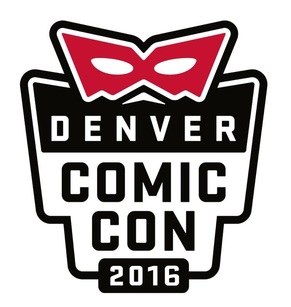 The Dark Side of Fandom Sunday, June 19, 2016 1:30pm-2:20pm Allison Ching, Curtis Sullivan, Moriah Hummer, Nathan Morimitsu, Nathan Scott, Shane Gomes Nerds and geeks are by definition fanatics. We have an inexhaustible enthusiasm for characters, stories, and other worlds that defines how we interact with reality. Fandoms are our communities, our family units that share the fervor, the obsession, the genuine love we feel towards content. We don’t just passively watch Game of Thrones play out on our TV screens and we don’t just turn the pages of Goblet of Fire with a critical detachment; we live in Westeros and we know that winter is indeed coming; we feel the excitement of the Quidditch World Cup as it plays out in our imagination. The Fandom Phenomenon provides fans with a community of peers that, at its best, fosters healthy discussion, speculation, communal support, and creativity. Organizations like the 501st Legion and Aurora Rise show the power of fans contributing to community outreach, charity, and recovery from tragedy. Unfortunately, the positive impact that organizations like the 501st and Aurora Rise have on the community can be overshadowed by the Dark Side of Fandom. Whether it’s the anonymity of the online comments section or the misguided presumptions of individual fans that turns the potential good a fan community can do into the harmful reality we see all too often, a Fandom can be quite destructive. Death threats, Geek Girl shaming, and Nerd Elitism are the most extreme examples of patterns of behavior that all Fans exhibit, however innocently, at some point. It can be as simple as the tone of voice used when saying, “Actually,” when correcting a fellow fan in a discussion of Superman’s powers in the New 52 Universe, championing the book series over the television adaptation of The Shannara Chronicles, or a subtle roll of the eyes at a cosplay costume that was bought at a store. The panelists at Denver Comic Con discussed several instances of more extreme examples of the Dark Side of Fandom, specifically the debate over the legitimacy of the new Ghostbusters film and the critical backlash received by Batman v Superman: Dawn of Justice. While I agree with the points that were made about the validity of an all-female cast for Ghostbusters and Zack Snyder’s humanity, I was more curious about what it is that Fan Culture permits that leads to such extreme and damaging arguments, and what we can do to change it. Now there is nothing wrong with correcting a fellow fan in a discussion or informing a fellow fan of something that they may not have read, but too often there is an assumption within the Nerd Community that a Fan with a particular lack of knowledge or a new fan is somehow lower and lesser than older fans who meet some unwritten criteria (i.e. If you haven’t read X, you can’t have an opinion, or if you like the TV series better you don’t understand the novels and so on). This response could be said to come out of a shared history of bullying among “older nerds.” As a member of a generation where nerds were bullied and shamed by more athletic or “cool” kids in grade, middle, and high school it is not difficult for me to understand the “oppressed nerd” mentality. I do not mean to equate nerd bullying with race, gender, or LGBT injustices by using the word oppressed, (as some nerd elitists would); however, I do believe it is an appropriate word for how it felt to be bullied as a nerd. The posture of the older nerd or nerd elitist is that of, “Fans, geeks, or nerds today did not have to and do not have to suffer as a result of their interests, therefore they have not earned the right to the title of Fan, Geek, or Nerd.” This is absurd. Too often we forget that the wedgies we endured, the bullying we experienced, and the shame we were made to feel, all for the sake of something unique and creative, something that captured our imaginations, and our endurance to stay true to our passions despite such actions, paid off in the end. What we loved, what we were bruised and hurt and shamed for, now rules the marketplace. Popular Culture bends over backward to please the nerds! Our opinions and our ticket sales impact what sinks or swims at the cinema, on TV, or in print. It’s not fair to hold our having been bullied against someone discovering what we’ve loved for the very first time. When I described scenarios where there was nothing wrong with correcting or informing another member of your Fandom I used a phrase which I believe captures the spirit of my argument here: Fellow Fan. Fellow means a person in the same position, involved in the same activity, or otherwise associated with another and that’s Fandom to a T. If we can treat fans old and new with the same level of respect, without unfair criteria for inclusion in our Fandoms, if we consider all fans to be fellow fans, perhaps the Dark Side of Fandom will fade and allow the light to shine more brightly. Written by Scott Murray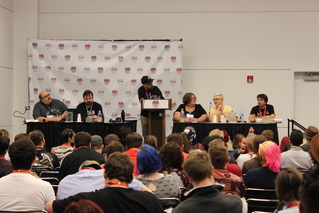 Denver Comic Con 2016 was my first ever convention. Never before had I been to a comic con, a gaming convention, an anime convention, or even seen cosplay in person. (Halloween doesn’t count, does it?) In fact, I’m pretty sure it was my first time inside a convention center. I spent most of my time upstairs on the main show floor, and although I explored the entire downstairs, I did not attend any panels. However, I’ve come to a conclusion: the real staying power of a con is in its panels, and, to a lesser extent, its guest appearances. You see, I arrived on Friday at 9am to meet John and get my media pass. We entered and wandered around the floor a bit, and I began shooting at 10 when the doors opened. I spent most of the rest of the day on that floor, both shooting pictures and just enjoying the con. I even bought some things for my wall. When I left sometime between 6 and 7 that evening, my day had been long and fulfilling. However, when I arrived on Saturday, this time when the doors opened at 10, and began to take more pictures, I found myself facing a bit of a conundrum. Whereas on Friday I had spent my time alternating between working and just enjoying the con, I found myself experiencing a little bit of déjà vu and well, the excitement faded for me just a little bit. Not that the con was boring, by any means, but simply because all the same shops, merchants, artists, and materials were on display. And I realized that they wouldn’t change during the entire con. No matter what time it was or which day, the only thing that would change were the people filling in the aisles. For this con that wasn’t a problem; my chief goal was to take pictures of interesting, cool, or otherwise appealing cosplay, so the new dearth of people each day provided plenty of material. But for my own personal enjoyment as a con-goer, this was a bit troubling. Although I did make a few purchases on my second day, I could have bought those things on my first. I simply waited because I knew I’d be back. Really, nothing had changed. I could see no reason to do anything other than show up one day, see everything, and leave. It made me wonder: why would I want to spend money, at any con, on coming more than one day? It took me an embarrassingly long time to find my answer: panels. Every day, every minute, there was another panel beginning in one of the many meeting rooms scattered amongst the labyrinthine halls of the lower floor. And what a range of topics they covered! Sound in film, gaming marketing, creative writing; anything you could think of for any kind of interest in any part of geek culture had at least one panel. I didn’t really want to attend any panels this time; I felt my time was better spent on the floor. But if I had been trying to attend panels, I might have had an existential crisis as I realized there simply weren’t enough hours in the day to attend everything that sounded interesting. Even a cursory glance at the panel schedule revealed a multitude of tempting, tantalizing options. It was here, I realized, that the value in a multi-day pass was undeniable. And, on top of that, attending on multiple days also gave multiple opportunities to attend celebrity appearances. Meanwhile, the merchants and artists provided a sort of connective tissue, filling in the gaps between celebrity appearances and panel start times. But now I know for the future, in order to truly experience everything that Denver Comic Con has to offer, one has to spend time in panels because that is where our minds are fed with fresh ideas and discussions about the things we love and discovering this, and the wealth of programming that DCC has to offer made my first convention experience a fulfilling one. Photographs by Scott MurrayPhotographs by Scott MurrayDenver Comic Con 2016 Panel Spotlight: Diversity in Sci-Fi, Fantasy & Comics (and why it matters)6/27/2016 Written by Tim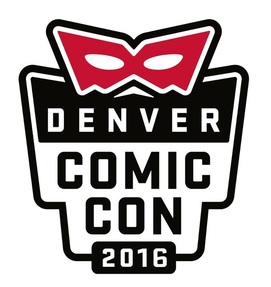 Diversity in Sci-Fi, Fantasy & Comics (and why it matters) Friday, June 17, 2016 6:30pm-7:20 pm Adelina Esquibel, Craig Volk, Emily Peros-McBreen, Josh Hem Lee, Regina Renee Ward My first panel at the 2016 Denver Comic Con (and ever for that matter) was “Diversity in Sci-Fi, Fantasy & Comics (and why it matters)” with staff members of the Denver Public Library. They began with staggering statistics showing how little of a role women, people of color, and especially LGBTQ people have played in films. There was one study on “The Diversity Gap in Sci-Fi & Fantasy Films as of 2014” which showed that only 14% of the films had a female protagonist, 0% had LGBTQ protagonists, 1% had a protagonist with a disability, and 8% had a protagonist of color (six of those were with Will Smith). They presented us with the obvious but important questions. How many characters of color are there? Of that number, how many have their own series? Since near the beginning of Marvel Comics, we have had disabled heroes like Professor Xavier, Daredevil, and more recently, Hawkeye (he is deaf). Lately they have become even more inclusive, with characters like Miles Morales (Ultimate Spider-Man) whose father is African American and mother is Puerto Rican, and Kamala Khan (Ms. Marvel) who is a Pakistani-American Muslim. This diversity however, is slow to trickle into the Marvel Cinematic Universe. The goal is not to remove Caucasian men from all comics and movies, the other groups just want their children and themselves reflected in the art forms that they love so much. So, what can we do to help? We can support the artists who are creating worlds with more diversity. We were supplied with an extensive “suggested reading” list, including comics and graphic novels like Rat Queens, Hilo, Little Robot, Bitch Planet, Saga, and Lumberjanes. If you are a heavier reader, then some of novels that might interest you are, Akata Witch by Nnedi Okorafor and Shadowshaper by Daniel Jose Older. On the small and big screen, there is the Netflix series Sense 8 and the upcoming Disney movie Sanjay's Super Team. Don’t accept cultural appropriation or whitewashing. Plenty of films have changed the gender/race/etc. of the characters (Avatar, Iron Man 3, Doctor Strange, Ghost in the Shell, etc.), but if you don’t buy it, eventually they will stop making it. If you are a creator, then create. We need more diverse books, comics, movies, etc., and you could even just start a blog or a web comic. Also check out some blogs that specialize in diversity such as NPR Code Switch, For Harriet, The Nerds of Color, and A Tribe Called Geek. Believe it or not, cosplay is one way we can help. The more Sam Wilson Captain Americas and Jane Foster Thors we see, the more they become common and normalized. Next up to discuss from Denver Comic Con's panels: The Force. 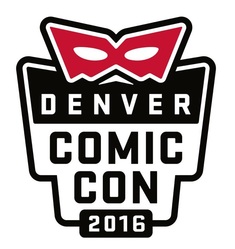 If you have ever wanted to find me at Denver Comic Con, I can give you one hint of where I will always be, I am with the artists. I get lost in Artist Valley every year and it never seems to get old, especially since I am able to find so many excellent pieces to add to my collection, along with meeting some freaking awesome people. One of the things that I love about Denver Comic Con is all of the local talent that is joined together at the event. Now don’t get me wrong, I am a sucker for some of the biggest names in the game, but I have met so many talented people that are right here in our own back yard that it's simply mind blowing. Now this year Artist Valley was massive and a little disorienting at first, but once you got your bearings, it was easy to locate your favorite artists and stop by their booths frequently. I did stick to my check list this year and even though I did not get a chance to stop by the big name tables, especially Stan Lee since his line was always several hundred deep, I did get some great finds this year and I have even added some new favorites to my list to check out next year. One of the people that I said to visit was Serna Illustration, run by Frankie Serna. I meet Frankie last year at DCC and picked up a great Venom print from him and I wanted to see more, since his style is mind blowing. With his design of the Snape-Ricot logo for this year’s DCC beer, I needed to see what else he had at his booth. I was happy to see a couple Denver Comic Con exclusives, a Deadpool and Harley that I will proudly be putting up on my wall, at least until he can give me something to relocate them. He is such a nice guy and he always has a smile on his face which makes him very easy to talk to, next I will have to ask him for a commission, because I would love to see what he could do with the Joker. I also mentioned Robert Elrod, mostly because I can never leave a show without picking up something from his booth to add to my collection. I picked up his book, Former Dwellings, mostly because it houses so many prints of his great work, but also because he was willing to add a sketch to the front cover. Now, if you know me, I do have a love for gnomes and Robert was able to make my dreams come true with a Gnome killing Zombies! This has easily become a prized possession for me and I cannot wait to find a way to display it, because I am blown away. He is always a joy to talk with during the show and a great source of information when I seem to fall short. 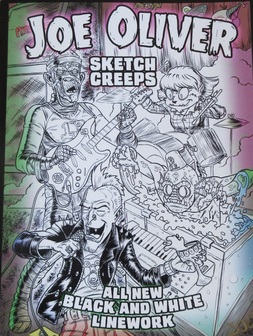 Joe Oliver has become a great friend over the years and his work is just phenomenal. One of the things that I like most about Joe, is that we have common interests and that seems to translate into the pieces that I like the most. This year I took a shot and picked up his sketch book that houses many of his great works, a couple of which I already own. Joe Oliver Sketch Creeps, a collection of black and white classic sketches from Joe, is a great collection of Joe’s artwork and a book that I am still in awe of since he has created so many great pieces of art.  I have been in the presence of Joe Becker at many cons now, but this time I actually got a chance to talk with him and pick up some art. But this time I did not go for the prints, I saw the premiere issue of Ti**ies and Fangs and had to grab a copy. Being a pin-up book this may not be safe for the kiddies to look at, but the artwork enclosed is phenomenal. With works from so many local artists, it is great to see such a collaboration come to life and leave me thirsting for more. I cannot wait to see what comes out in Volume Two, as it will blow your mind as it did to me. With so many other great pieces at his table, I cannot wait to make my next purchase from him.  I always have a good time at Denver Comic Con and one of the major reasons is that I get to see the same people year after year and one of these people is Jay Peteranetz. Doing the badge artwork for DCC last year, Jay was able to secure a booth right where he was sitting last year, so he was very easy to find. As I mentioned on my artists to visit article, Jay is the artist behind the Magicians Must Die card set and I did end up with my own set this year around. When talking to the salesman, I was sold on Set #3, mainly because it has a flip book addition to it, along with the running comic on the back of the cards. If you have not seen Magicians Must Die yet, you need to check it out, it is a brilliant idea and with Jay doing the artwork, you know you cannot go wrong. 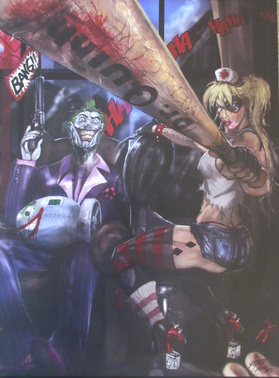 Making sure to stop by Lewis Brown’s table to pick up his Joker/Harley print, I was lucky enough to get a glimpse of his new book, The Brown Hornet Omniverse. Just flipping through the pages, it was easy to see how much work went into bringing it to life. Doing every aspect of the book on his own, Lewis has done a great job putting it all together in such a short time. I cannot wait to get my hands on the book when it is officially released, especially since the art on the pages is great and the story has been on his mind for over a year. I was lucky enough to be invited to sit with a group of artists on Saturday night after Denver Comic Con shut down. While chatting, I got to see some of the artwork from Patrick Canter who has a style all of his own. When stopping by his table and seeing more of his prints, I was blown away and had to pick up a couple. Since I am a huge Joker fan, I found that his print of Villains of Gotham would feed my need for that, but all of the characters look great. Also finding a cool Boba Fett, I think I made out like a bandit with a great sample of his work. 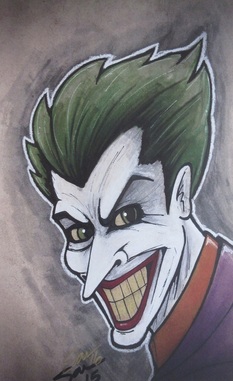 I also spoke with Sal Galindo from CCP Comics who has a huge fan base that loves his Stitch characters dressed up as any superhero. But I found that I was more attracted to his Day of the Dead series of princesses as they are something different and I have not seen it before. With two really cool series that are growing, of course I had to pick up a Joker from Sal, since it is my goal to get at least one from every artist that I like. I cannot wait to see what Sal is able to come up with next, since his Day of the Dead series is phenomenal and something that needs to be checked out, even if you are not a fan of princesses. 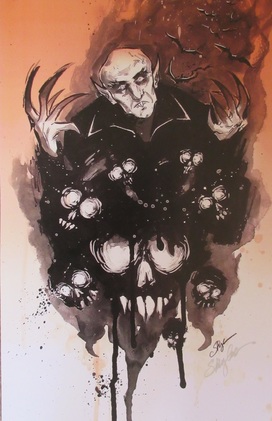 I then got to meet Skylar Patridge, who everyone in the group continuously raves about and after I saw a commission that she was working on of the Rocketeer, I could see why. Skylar is able to bring any piece she does to life with very minimal color, most of her best work is just black and white. I was blown away when I stopped by her booth and looked through her originals and there is a Daredevil that I might need to invest in sometime in the future. I picked up a Nosferatu print because it seemed to speak to me from the wall and will have a commission coming my way soon, because I wanted to see what she is able to do with a character that is near and dear to my heart…Batman. 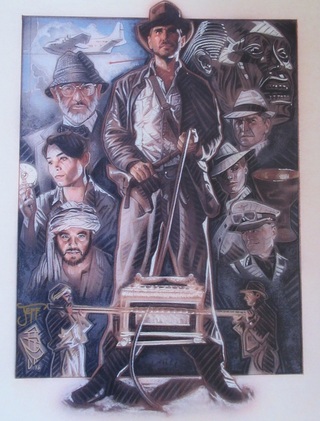 My last stop of the show was to get a piece of artwork from Jeff Herndon, maybe for me, or maybe for a Father’s Day present, I am still not decided. This Indiana Jones piece had been speaking to me ever since I saw the first picture of it being completed and now a print has made its way into either mine or my father’s collection. I love following Jeff’s art page, especially since he gives progress shots on his works and what you see in the beginning is amazing, but the finished product is beyond mind blowing. It was nice to get a couple of seconds with Jeff this year, especially since his booth seemed to be kicking every time I walked by. 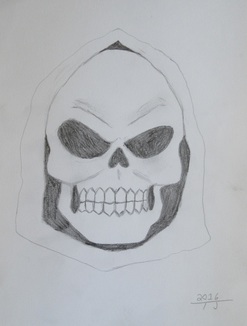 I also got a great piece from Todd Jones this year. It's been amazing watching Todd's talents grow over the past year ever since he started to do sketches. I love Skeletor and the story that goes along with him from Todd. I am happy to see Todd working on artwork and he said one thing that will stick in my mind for years to come, ‘writers should have to draw’. There is a story for this, but it can wait for another time. I hope to see more of Todd Jones’s artwork in years to come. There you have it, here is the artwork that I have picked up this year at Denver Comic Con. I think I made out like a bandit and got to meet and talk with so many great artists while walking up and down the rows. This has to be one of my favorite recaps to write every year, mostly because I love artwork and will need to buy another house with massive walls to showcase everything that is in my growing collection. I cannot wait to see what this awesome group will bring to the show next year, as they never stop working and it is great to see how they grow from year to year. Written by Scotty Most of the time Sunday’s are the down day of the con as everyone is so tired from running around the previous couple of days, but not at Denver Comic Con this year. Although the opening line could not compare to Saturday, seeing people file in throughout the day, it appeared to be double the crowd from Friday. And with the appearances of Clark Gregg and Jeffrey Dean Morgan for one day only, it looked like everyone had their agenda set and were ready to move as they entered the convention center. Keeping an eye on Artist Valley, it was fun to see more and more people filter back to booths at the end of the rows, seeing that there were more artists waiting to be discovered. While several artists were working to get their commissions done before the final bell, they were more than willing to take a break and talk to their new fans. As Artist Valley continued to fill up, it was also great to see Author Alley get plenty of looks, especially at the Barnes and Noble booth where they had been featuring big name authors all weekend long. As this is the day that I roam the halls a bit more than normal, I did notice that the weather did not stop any of the cosplayers from doing their thing. As I ran into a tall Groot, a taller Galactus and a massive Minotaur, it was apparent that nobody was letting the scorching hot temperatures keep them down. With more photos being taken of the cosplayers than I have ever seen, it is great to see that all of their hard work paid off for the weekend. 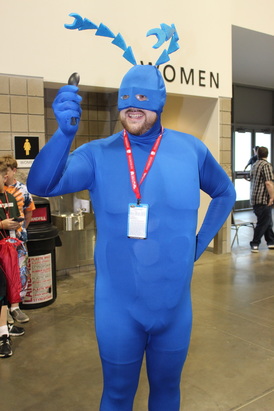 It was also great watching the celebrity lines, especially for Stan Lee and Clark Gregg as they were continuously wrapping around as people were waiting to meet some of their favorite characters. Also watching the 5280 Stage, it did not feel like this was the last day of Denver Comic Con, it felt like we were just getting started again. But when the speakers came alive and the fifteen minute warning was issued, you could see the disappointment in everybody’s eyes. With only a couple minutes left to say goodbyes to new and old friends, along with picking up one last thing from the booths, it became real, Denver Comic Con 2016 had come to an end in classic fashion. With a massive crowd of almost 115,000 people, Pop Culture Classroom and Denver Comic Con have given us all a place where we can geek out and meet so many great people. There seems to be something in the air when it comes to this con and when talking to many different people from out of state, they all love how calm and cool it really is. With more a relaxed feel to it, this is one of the things that makes Denver Comic Con stand out from the rest. And with proceeds going to fund Pop Culture Classroom, our local youth will have many advantages inside the classroom to learn and grow with so many programs that will get them ready for the real world, along with the Comic world. This is one of my favorite events to go to every year, not because of all of the great guests that make appearances, but the people. It is easy to forget that movie stars, artists and authors are just regular people and when you get to talking with them, they can be just a star struck as you are. It is funny to hear people coming back from meeting their heroes say they are extremely chill and they could not have imagined that at all. It has been another great year from Denver Comic Con and a huge thanks to everyone that worked so hard to make it happen. I hope everyone enjoyed their time down there as much as I did, there is something magical about this event that always leaves me in awe when it is over. I cannot wait until next year to see what happens next with this great event! |
Archives
October 2024
|
|
© 2012-2024, Nerds That Geek LLC.
All Rights Reserved. |
uWeb Hosting by FatCow

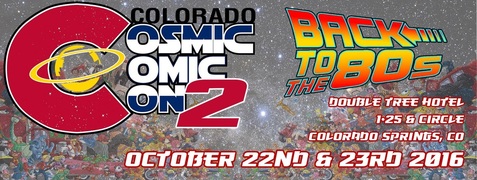
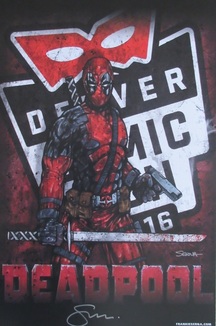
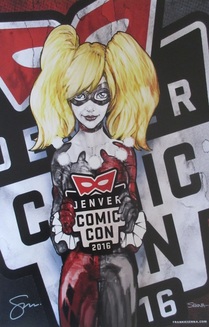

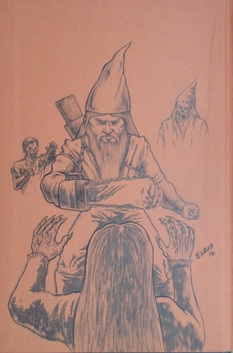
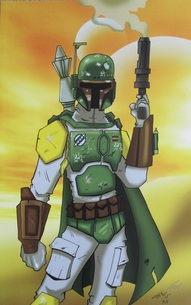
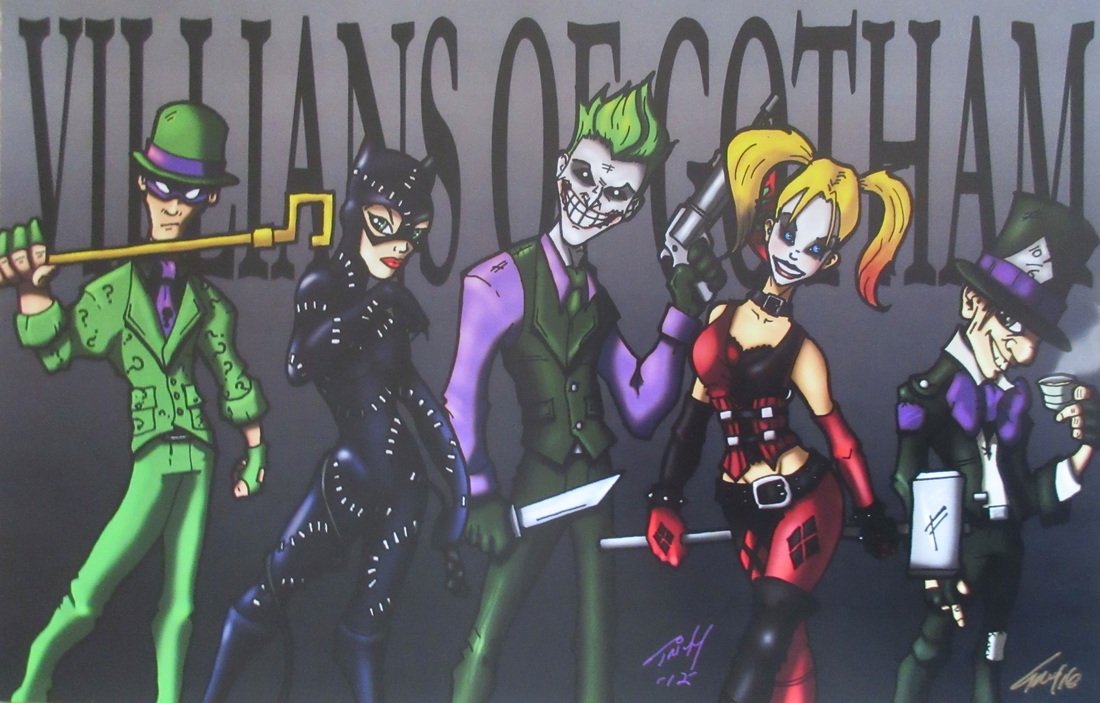

 RSS Feed
RSS Feed